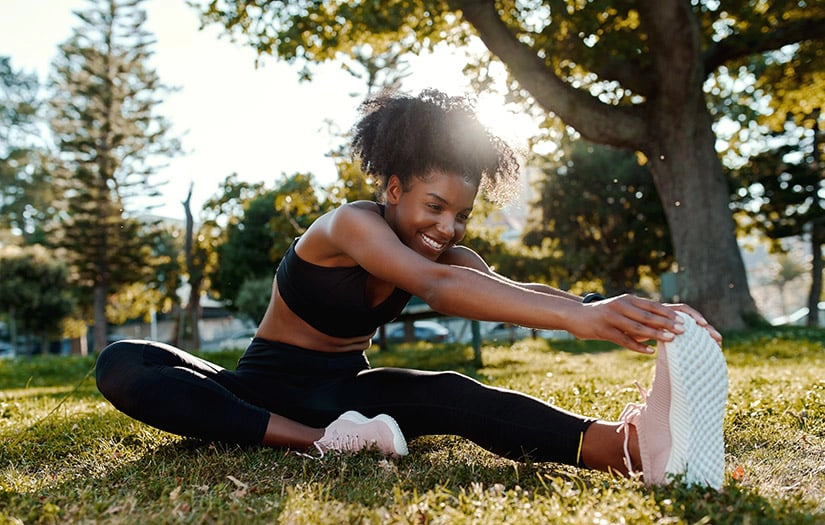Introduction
Many people feel stiff and sore after sitting at a desk all day. This discomfort can make everyday tasks challenging. Stretching is the key to solving this common problem. It keeps muscles flexible, strong, and healthy.
This article will explore the many benefits of stretching, from improving flexibility and joint health to boosting circulation and reducing stress. You’ll learn how to easily add it into your exercise routine for better overall health and fitness.
Discover why stretching should be part of your daily life!
Why Stretching is Important
Stretching plays a crucial role in maintaining flexibility. It enhances joint movement and helps prevent injuries during physical activities.
Improved flexibility
Flexibility plays a crucial role in overall muscle health. Increased flexibility allows muscles to lengthen, which enhances their ability to perform physical activities effectively.
This improvement helps maintain a good range of motion in the joints, making movements smoother and more controlled. Flexible muscles can react better during exercise, reducing the risk of injury.
Blood circulation benefits from improved flexibility as well. Stretching increases blood flow to the muscles, delivering oxygen and nutrients vital for performance enhancement. As muscles become more flexible, they prepare themselves for strenuous activity.
With greater flexibility and range of motion comes better overall health and reduced body pain.
Range of motion in joints
Stretching plays a vital role in maintaining the range of motion in joints. It keeps muscles flexible, strong, and healthy. A good range of motion allows joints to move freely without pain or tightness.
Stretching increases flexibility as it lengthens muscles. This improved flexibility helps in achieving better movement during physical activities.
Maintaining joint health aids injury prevention. Tight muscles can restrict movement and increase the risk of injury. By stretching regularly, one prepares the body for exercise and enhances performance in various activities.
Proper execution of stretches ensures effective results while boosting blood circulation to the muscles, leading to overall better health. Next, we will explore different types of stretching techniques.
Types of Stretching

Stretching comes in various forms. Dynamic stretching involves movement, while static stretching focuses on holding a position.
Dynamic stretching
Dynamic stretching involves moving parts of your body through their full range of motion. This type of stretching helps improve flexibility and prepares the muscles for exercise. It increases blood flow to the muscles, boosting oxygen levels and nutrient delivery.
A proper warm-up with dynamic stretches can enhance performance in physical activities.
Exercises like leg swings or arm circles engage multiple muscle groups. These movements not only lengthen the muscles but also promote joint mobility. Incorporating dynamic stretching into your routine reduces the risk of injury by preventing tight muscles from limiting movement.
Regular practice ensures better muscle and joint health while enhancing overall workout effectiveness.
Static stretching
Static stretching plays a crucial role in flexibility training. This method involves holding stretches for a set period, usually 15 to 60 seconds. It lengthens the muscles, making them more flexible and enhancing overall movement capabilities.
By incorporating static stretching into your routine, you support improved performance during physical activities.
This technique also increases blood flow to the muscles, which boosts oxygen levels and nutrient delivery. Better blood circulation prepares your body for strenuous activity while promoting muscle health.
Regular static stretching reduces the risk of injury by preventing tight muscles from limiting full extension and range of motion in joints.
Effectiveness of Stretching
Stretching plays a vital role in keeping muscles flexible, strong, and healthy. This practice allows the body to maintain a full range of motion in the joints. Flexible muscles improve performance in physical activities.
They also help prevent injuries by ensuring that muscles do not tighten excessively.
Improved blood flow is another key benefit of stretching. Increased circulation boosts oxygen levels and nutrient delivery to muscles. This preparation enhances overall muscle health and helps individuals tackle strenuous activities with ease.
Regularly incorporating stretches into exercise warm-ups can lead to better workouts and reduce soreness afterwards.
Benefits of Stretching
Stretching offers many advantages that can significantly enhance your physical health. It helps improve performance, reduces the risk of injury, and promotes overall muscle wellness.
Improves performance
Proper stretching improves performance in physical activities. Flexible muscles work better and allow for smoother movements. Stretching increases flexibility, which helps athletes excel in their sports.
It prepares the body for exercise, making workouts more effective.
Good blood flow results from stretching. Increased circulation boosts oxygen levels and nutrient delivery to the muscles. This helps them perform at their best and recover faster after activity.
Keeping muscles flexible also reduces the risk of injury during intense workouts or competitions.
Reduces risk of injury
Stretching plays a vital role in reducing the risk of injury. It keeps muscles flexible, strong, and healthy. Flexible muscles promote full extension during physical activity. This flexibility prevents tight muscles from causing strains or tears.
Stretching also prepares the body for exercise, enhancing performance and minimising chances of accidents.
As you stretch, blood flow to your muscles increases. Better blood circulation boosts oxygen levels and nutrient delivery. Improved circulation ensures that your body stays healthy overall.
Incorporating stretching into your routine can be a simple yet effective warm-up strategy for better posture and stress reduction too. Regularly stretching not only benefits muscle health but also supports an active lifestyle free from injuries.
Increases flexibility and range of motion
Flexibility plays a crucial role in overall physical health. It keeps muscles flexible, strong, and healthy. Improved flexibility allows for a greater range of motion in joints. This increased capacity helps prevent injuries during exercise or daily activities.
Stretching lengthens the muscles, enhancing their flexibility and adaptability.
Blood flow to the muscles increases as you stretch. Better blood circulation boosts oxygen levels and nutrient delivery to tissues. With improved flexibility, athletes can perform better in sports and other physical activities.
Maintaining an effective warm-up routine with stretching exercises is essential for optimal performance and injury prevention. Next, we will explore different types of stretching techniques you can use to benefit your body effectively.
Promotes muscle health
Stretching promotes muscle health by keeping muscles flexible and strong. Flexible muscles can better support your body during physical activities. This flexibility helps improve performance and reduces the risk of injury.
Tight muscles can hinder movement, making it difficult to achieve full extension. Stretching also increases blood flow to the muscles. Better blood circulation boosts oxygen levels and delivers essential nutrients.
Regular stretching is crucial for maintaining healthy muscle function. It prepares your body for exercise, allowing for a more effective workout. Performing stretches enhances overall wellness in addition to improving posture and reducing body pain.
Now, let’s explore how to incorporate stretching into your exercise routine effectively.
Boosts circulation
Stretching boosts circulation throughout the body. Increased blood flow delivers more oxygen and nutrients to your muscles. It prepares them for strenuous activity, enhancing overall health.
With improved circulation, you feel energised and ready to perform better in physical activities. Blood flow aids muscle recovery, reducing soreness after exercise. Keeping muscles flexible helps prevent tightness that can lead to injuries.
Incorporate stretching into your routine for better performance improvement and posture enhancement. By improving circulation, stretching plays a vital role in maintaining healthy muscles and joints.
How to Incorporate Stretching into Your Exercise Routine
Start every workout with a proper warm-up. Include stretches that target different muscle groups to keep your body flexible and strong.
Importance of warming up
Warming up is vital for preparing the body before exercise. It helps increase blood flow to the muscles, which boosts oxygen levels and nutrient delivery. This process prepares muscles for more strenuous activity.
By warming up, individuals reduce the risk of injury caused by tight muscles that hinder full extension. Stretching during the warm-up improves performance in physical activities and enhances overall muscle health.
Incorporating effective stretching exercises can help target different muscle groups effectively.
Stretching exercises for different muscle groups
Stretching exercises target various muscle groups to improve flexibility and performance. Focus on the major areas like arms, legs, back, and shoulders. Simple stretches such as arm circles enhance shoulder mobility.
Quadriceps stretch helps in maintaining flexibility in the thighs.
Target hamstrings with a standing forward bend for better range of motion. The seated butterfly stretch opens up your hips effectively. Stretching increases blood flow to the muscles, boosting oxygen levels and nutrient delivery.
Consistent practice decreases the risk of injury while keeping tight muscles at bay.
Proper execution
Proper execution of stretching ensures maximum benefits. Perform each stretch slowly and gently. Hold each position for 15 to 30 seconds. Focus on breathing deeply throughout the stretch.
This helps relax your muscles.
Target different muscle groups during your routine. Warming up properly before stretches prepares your body for exercise. It increases blood flow to the muscles, boosting oxygen levels and nutrient delivery.
Strong, flexible muscles improve performance in physical activities and reduce the risk of injury by preventing tight muscles from hindering full extension.
Frequency and duration
Incorporate stretching into your exercise routine regularly. Aim for at least three to five times a week. Each session should last around 10 to 30 minutes. This duration allows enough time to stretch each muscle group effectively.
Stretching before workouts acts as an essential exercise warmup. It prepares the body and improves overall performance.
Vary your stretching techniques based on activity intensity and goals. Dynamic stretches work well as a warm-up, while static stretches are effective in recovery phases. Focusing on frequency and duration enhances flexibility and reduces the risk of injury significantly, making your muscles healthier overall.
Knowing how to execute these stretches properly ensures you gain maximum benefits from each session.
Next, explore the various types of stretching available to enhance your routine further.
Conclusion
Stretching plays a crucial role in maintaining muscle health. It increases flexibility and promotes better performance during activities. You can easily add stretching to your routine with simple exercises for each muscle group.
Consider how these strategies might reduce your risk of injury and improve your overall fitness. Start stretching today, and feel the positive changes in your body!
FAQs
1. What are the benefits of stretching?
Stretching aids in posture improvement and provides relief from body pain.
2. How does stretching help with my posture?
Regularly practicing stretching can correct misalignments, leading to an improved posture.
3. Can I use stretching for body pain relief?
Absolutely! Stretching exercises can alleviate tension in your muscles, providing effective body pain relief.
4. Are there any other noteworthy benefits of regular stretching aside from posture improvement and body pain relief?
Indeed, besides improving your posture and relieving body pain, regular stretches also enhance your flexibility and range of motion.






